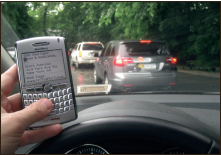Driving impaired
Texting while operating a vehicle equals drunk driving
Many teenagers use their thumbs nowadays to make plans with their friends on a Friday night. Since its debut in 1989, texting has become a phenomenon across the United States. According to the Cellular Telecommunications Industry Association, over 1.6 trillion text messages were sent per day in 2009.
The key selling point of texting is that it saves time. In many cases, people are so eager to speed up communication that they have adopted the dangerous habit of texting while driving. Unfortunately, this short cut is an action that can lead to shortened lives.
According to a recent Virginia Tech Transportation Institute study, the reason for this may be linked to the fact that texting while driving is the equivalent of drunk driving, slowing a driver’s reaction time to that of someone with a blood alcohol level of .08.
“The results don’t shock me,” Lynchburg Behind the Wheel Instructor John Mann said. “I actually would have thought they’d be worse than that.”
Mann, who has been teaching Behind the Wheel for about 15 years, has lost former students due to texting while driving.
According to the Insurance Institute for Highway Safety, drivers using hand-held devices are four times as likely to get into crashes resulting in serious injury or death. Despite these disturbing results, the Governor’s Highway Safety Association website revealed that only 30 of 50 states have opted to ban the behavior.
Amherst County Police Officer Art Pedigo said that texting while driving is one of the most dangerous driver actions because it distracts a person in three ways.
“They’re visually distracted when their eyes come off the road to read that text,” Pedigo said. “Then there’s manual distraction when they take their hand off the wheel to type, and there’s cognitive distraction during all of this because their mind is on the message being sent and not on driving.”
Pedigo takes this combination seriously because he has seen it end in deadly results.
“It takes one second to cross over the road line and strike a mini-van with kids on their way home from little league practice,” he said.
Nineteen-year-old Shelly Holmes did not collide with another vehicle, but she did damage her 1996 Jeep Grand Cherokee when she hit a deer this past October because of texting while driving. Holmes was texting a friend to tell him she had gotten off work and would be at his house soon when the accident occurred.
“I didn’t even see the deer until it was too late to stop,” she said. “When I got home, I saw some of the deer’s fur in my front bumper and lost it. I really could have died.”
Many people do not live to see the person they were texting. According to a September 2010 report from the Transportation Department 5, 474 people died in 2009 from cell phone use, including texting and talking.
“Those numbers are going to keep going up if people don’t unglue their hands from the keyboard,” Pedigo said. “There’s just no excuse for it.”
According to the AAA Foundation for Traffic Safety’s third-annual Traffic Safety Culture Index conducted in September of 2010, 70 percent of the drivers they surveyed admitted to texting while driving.
“Everyone thinks they’re invincible, and that it won’t happen to them,” Brookville High School Driver Education teacher Warner Dyke said.
Dyke, who has been teaching the course for 14 years, said he tries to get through to his students by role playing and bringing in a former student who was hit walking on a sidewalk by a driver who was texting.
“We try to get parental support too, but some of them are just as bad,” Dyke said.
In fact, 2010 texting while driving statistics compiled by Pew Research Center revealed that 47 percent of adults text compared to 34 percent of teenagers.
“I see my mom text all the time,” a 16-year-old Halifax County resident said. “Why would I stop doing it if she won’t?”
According to Pedigo, another reason people continue to text while they drive can be attributed to the lack of harsh penalties and laws associated with the action. In states like Virginia, texting while driving is a secondary offense only resulting in a $20 fine the first time and a $50 fine if caught a second time.
“There’s no severity in the punishment so everyone just ignores it and goes on their merry way,” Pedigo said. “If we could slap them with a $1,000 fine they’d start listening.”
Various ads, programs and organizations have been put in place to discourage drivers from texting. Public Service Announcements are being released frequently, showing graphic dramatizations of possible texting while driving outcomes in hopes of emphasizing the severity of the action.
Celebrities like Oprah Winfrey have also gotten in on the movement. Winfrey launched a “No Phone Zone” campaign in 2008, while President Barack Obama also took a stand against this dangerous epidemic by signing an executive order in 2009 banning texting while driving for over 4.5 million federal government and military employees.
Text’n Drive allows drivers to stay focused by sending text messages without touching their phones by using a voice activated program to speak their texts out loud.
“Instead of complaining, we came up with an alternative to make roads safer,” employee Hugo Hang Hong said.
The Coalition for Cellphone-Free Driving also runs ads reminding drivers of ways they can avoid distraction, such as getting a passenger to operate all of their technological devices or turning their phone off before even getting into the car.
Editor’s note: Some names have been changed for the protection of the individual’s privacy.

